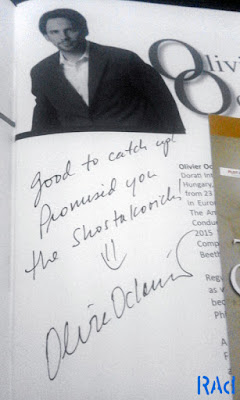 |
| Conductor Olivier Ochanine |
Concertgoers hoping for a post-Valentine’s night filled with romantic music were probably caught unaware as war music instead echoed inside the halls of the Cultural Center of the Philippines at the latest concert of the Philippine Philharmonic Orchestra that reunited them with former principal conductor/music director Olivier Ochanine.
Taking a breather from the PPO’s
back to basics season, Olivier presented Pyotr Ilyich Tchaikovsky’s Marche Slave in B flat minor, Op. 31, Franz
Joseph Haydn’s Symphony No. 88 in G
major, Hob. 1/88, and a major work from the mid-20th century, Dmitri
Shostakovich’s Symphony No. 10 in E
minor, Op. 93.
The realization came to me right
after the concert that most of the night’s program was war music. I am fully
aware of the circumstances that led to the composition and the nature of the
Shostakovich symphony but it somehow passed my mind that the Tchaikovsky work
is actually a rousing call to arms against the enemy. With the Marche Slave in B flat minor, Op. 31, Olivier
wielded the orchestra to convey the primary theme’s increasing intensity. A patriotic
and much romanticized take on war, this music didn’t let me feel the horrors
and the grim reality of engaging into battle. No wonder it took me some moments
to realize the true programmatic nature of this wok.
No traces of war at all could be
heard when the PPO performed Franz Joseph Haydn’s Symphony No. 88 in G major, Hob. 1/88 which I think is a great
example of what a classical era symphony is. Cheerful, light, and sweet as a
cotton candy, the PPO breezed through it. Keen eared regulars would’ve noticed
how the Finale theme of this symphony was used in Ludwig van Beethoven’s Symphony No. 1 in C major, Op. 21.
The Shostakovich symphony, on the
other hand, was in direct contrast with the previous pieces. Filled with
tension, defiance, violence, unease, and fear, the shadow of Stalin looms over
this piece, offering no sense of relief even if this was completed months after
his death. I’ve listened to recordings and watched performance videos numerous
times but nothing still compared to experiencing the orchestra bring out the
music live. The lower strings continued their streak of sounding rich and
robust heard especially during the opening measures and the contrabassoon once
again was crisp. Not surprisingly, the solo horn was shaky and had a few
hiccups.
Knowledge about the symphony like
how it relates to Soviet/Russian history and the rest of Shostakovich’s works,
and knowing the "DSCH" and "Elmira" motifs inserted in the music definitely add to
my greater appreciation of the piece. Olivier touched upon these during his pre-concert that which made a return for this evening. But even if I strip away all the
historical and political context, I could still see and hear the merits of the
piece with its structure, the contrasts, and the mood that it communicates.
This performance of the Symphony No. 10 is Olivier’s third Shostakovich symphony with the PPO following the Symphony No. 5 in April 2010 and Symphony No. 1 back in September 2015. I personally dig Shostakovich’s works especially his symphonies, string quartets and concertos even if his music may not be everybody’s cup of tea. For me whose music tastes gravitate towards the 20th century works and beyond, this concert was a welcome break from the current season’s focus on the classics.



No comments:
Post a Comment